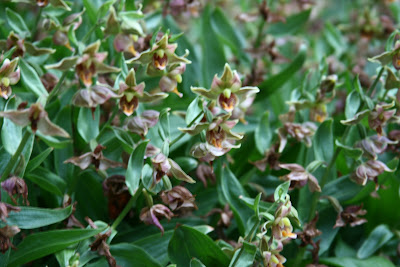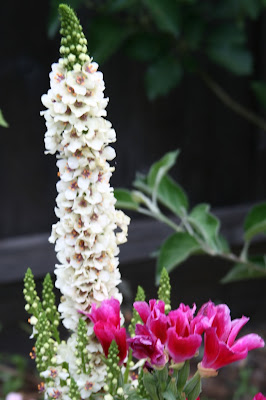Yes, friends, it's Garden Blogger's Bloom Day again. Carol at May Dreams Gardens, is inviting all Garden Bloggers to show photos of the blooms that delight their hearts. This being June, I expect to see roses, beautiful tableaus of extraordinary plants. This time of year, I'm always tempted to go the the Garden Center and stock up on foxglove and pansies. But then, where would I put them?
The front garden (above) is aglo with Mimulus (monkey flower), Salvia apiana (white sage), and Triteleia Queen Fabiola (Ithuriel's Spear) set off nicely by a 3x5 area of bright green Baccharis pilularis (coyote brush).
Here we're taking a closer look at the Mimulus, which has Trichostema lanatum (Woolly Blue Curl) right next to it.
A second Trichostema plant, more toward the end of the dry stream bed.
And a close-up.
Here a close-up of a native bee (or bumble bee) on Salvia apiana, which actually translates as bee sage.
Also stunning this year is Dudleya farinosa (cliff lettuce), a native succulent that lives in coastal areas, photographed here against the coyote brush.
In summer, all my Dudleyas don't look so great. I think most of them would like foggier and moister conditions. But right now, they're impressive and a little other-worldly looking.
In the back garden, I pulled almost all the poppies and it's now possible to see the lavenders and Salvia clevlandii.
It was quite a job to remove a full toter full of poppies, well past their prime. But I was happy to be able to see my Asclepias speciosa (Showy milkweed), which bloomed for the first time this year. On the right, a Salvia spatacea (hummingbird sage).
The grass is a mediterranean grass, Stipa gigantea, which does well without summer water and, at over 8 feet, adds some drama to the back garden.
Drama at a smaller scale is supplied by Epipactis gigantea (stream orchid), which, despite its promising name, doesn't grow much taller than a foot, but spreads nicely under favorable conditions.
And I'm very impressed by Clarkia 'Pink Ribbons', a shade-tolerant clarkia that I've planted in pots.
I love a plant that can bloom under the redwoods.
More suprises are around the corner. Here, in the sun, Clarkia ungiuculata (elegant clarkia) and Clarkia amoena (farewell to spring) are reigning supreme.
With little surprises tucked away here and there. Allium christophii (star of persia) managed to make it through the winter and has sent beautiful big blooms through the coyote brush. Here, it's framed by Clarkia u. and a Japanese maple.
And here, we have Clarkia a. with Verbascum chaxii 'Wedding Candles'. This non-native plant can be invasive with enough moisture, but this far south, the danger is negligable.
But the best surprise happened Sunday morning. As we were having breakfast outside on a warm day, I noticed something bright yellow in the Japanese maple. I was immediately a bit indignant. Had someone thrown a candy wrapper into my plant?
But no, I'd gotten indignant just a bit too sun. This was Calochortus luteus, a native bulb I had planted in the fall. I'd planted about 25, and most never made it. But the ones I had planted in the maple put were opening now, in June.
And with that happy news, I'm ready to go over to Carol's and see what everyone else has to offer for bloom day. Won't you join me?
Postscript: Queerbychoice correctly identified the native bulb, which is Calochortus luteus, not Mentzelia laevicaulis (blazing star). I corrected the original post. Thanks!


















Comments
Mentzelia laevicaulis photos
Happy Bloom day!
Remind me to give you some Dudleya hassei next time I see you (if you'd like it). The Dudleya stems against the Baccharis are just stunning.
1. Chandra, There are many sages, and my sages are not the culinary sage though the white sage is the sage used in smudge sticks.
2. Helen, The Dudleya behaves like a sedum and starts from scratch each year.
3. Ms. Curbstonevalley, The Asclepias was from Yerba Buena nursery. You can always look at the CA Natives Link Exchange (http://www.cnplx.info/) if there's a plant you can't find. I have to warn you, they go dormant early and wake up late, but I'm doing it for the butterflies.
Thanks all for visiting! BTW, I also just discovered the first ripe plums. What a wonderful day!
The salvias are very wonderful too.